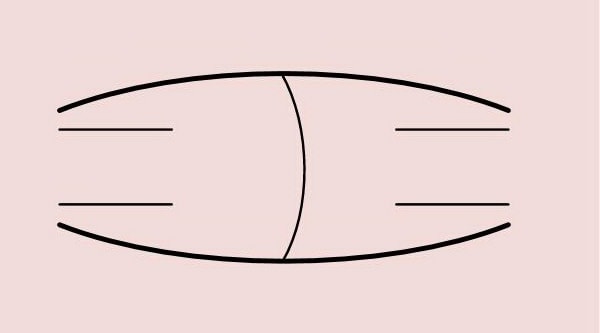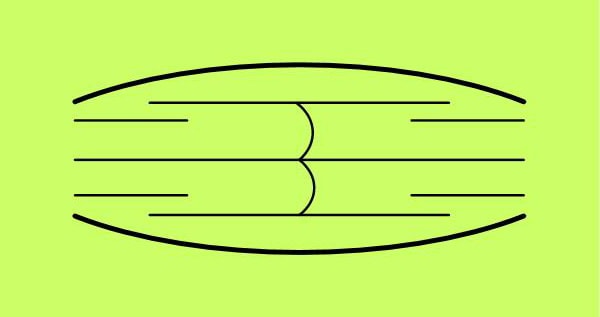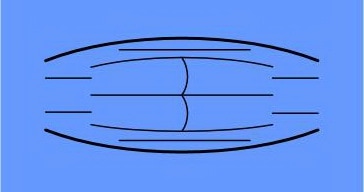Different brands have different philosophies. But one thing is the same for everyone:
The mathematical relations of the flow mechanic. In the following text I will give an overview of the common channel types of kiteboards and how they behave in the water.
The “flat” running base
In the beginning of kitesurfing the majority of the kiteboards were produced in ski- or snowboard factories. The flat running base is the right choice for riding snow, but not suitable for liquids. Water is squeezed out to the side and this slows down the flow in long ways direction. Due to the Bernoulli Effect the board sticks to the water. On the low end you notice, that it doesn‘t want to start. At the high it‘s difficult to control, doesn‘t hold the edge. Riding is tiring and no fun. From the hydrodynamic point of few I recommend converting it into a wardrobe and switching to a kiteboardboard with a modern shape.
The „single concave“
The single concave is the simplest 3D shape. Design and production takes place in 2D, in the press the board is bent over an insert. Even small concaves improve the riding characteristics immensely. On the foot sole you perceive a loose feeling, the generally low resistance of these kind of boards offer a good low end and nice mean wind sessions. At the high you reach the limits of these boards, you might be dragged lee wards. Also finding the pop and jumping will be tricky. The single concave is the best choice for schools and beginners and less ambitious free riders. Typical representatives of this genus are the NORTH PRIME, or the WOODBOARD BEAM
The „tip channels“
The tip channels were the state of the art in kiteboard design for many years. Relatively easy to manufacture, in combination with a concave running base they resulted in usable and fine freeride boards with some freestyle characteristics.
Light-footed on foot sole and depending to the channel depth enough grip for hooked and unhooked take offs.
Though the range of comfortable use is limited, do not provide a stable low end and in high winds they do not put up this amount of leeward resistance what the rider needs to hold the edge. Even though the tip channel is not the latest innovation, it is still very popular with many riders. A typical representative of this genus is the DUOTONE SELECT.
The double concave and the single concave with curved side channels
Though these channels look different, the behaviour in the water is almost equal. The constricting channels create the identical hydrodynamic reaction. Due to the Bernoulli (Venturi)-effect the flow underneath the boards speeds up and gains some energy. This energy comes as an extra buoyancy force which provides this incredible low end of these kind of boards. The keel of the double so as the curved side channel makes the heel all time present, loading the kite and popping turns to a child play. On the foot sole this shape comes quite loose with a responsive heel, a pronounced straight run with little steering effort. The generally low resistance of the shape let the kite fly far to the edge of the wind window, and little steering effort brings back the kite to the power zone. The range is huge, from low end to strong winds, from chilled freeride to ambitious old school. The double will land softer, the constricting side channels will provide a bit more low end. This shape is the highest standard in freeride kiteboards. Typical representatives of this genus are the CARVED IMPERATOR or the WOODBOARD CRBN / CHAME.
The parallel multi concave
The parallel – three or four – channels induce high resistance in all riding directions – except straight downwind. Consequently the board keeps any kite constantly in the centre of the wind window. The parallel multi channels love strong winds, high jumps and ensure that the landing is direction stable. On the foot sole you feel the resistance of the board like a slightly drag, which gives the rider in heavy winds good control and a close connection to the kite. This shape asks for one bigger kite size. A typical high performance representative of this genus is the OZONE TORQE V2
The parallel double concave
This shape has a wide range of use. The double prevents some flow escaping to the side, so the feeling on the foot sole is quite loose. Handling of light, until strong winds is easy, even though it does not reach the low end of the constricting channel -neither the high end of the multi concave. A compromise for an ambitious free rider. The keel offers some feedback that you need for loading and take offs, though the genetic of the shape supports more hooked and old school. The double provides soft and direction stable landings, what invites the rider to some big air. Experienced freestylers will handle unhooked moves as well. A typical high performance representative of this genus is the AIRRUSH APEX TEM V 7
The parallel double concave with straight side channels and pronounced tip channels
These shapes provide this amount of resistance that keeps the kite in the centre of the wind window, ready for immediate unhook action. The straight side channel generate this resistance and make the heel present and potentially active. The double concave stands for controlled and direction stable landings. In the moment of impact the keel brakes water surface and diverts it to the outside. The tip channel put up that grip that you need for fast freestyle moves. On the foot sole this shape comes with extremely high connection to the board, small steering effort and very good control. Popping works precise without any slip away. It‘s the shape of choice for high performance freestyle and wake style riding. This shape represents the masterclass in board shaping. Typical high quality examples of this genus are the DOTONE TEAMSERIES (HEADLOW) TEXREME, LIEUWE OCEANA and the WOODBOARD TRASH.
The constricting double concave with straight side channels and pronounced tip channels
This shape is a 100% Big Air shape. The side channel provide maximum leeward resistance, avoids the kite flying to the edge and build up a maximum of line tension. The constricting double speeds up the flow underneath the tip, what crates this additional lift, what you feel in making more height. The keel of the double breaks water surface and divides it to the outside. The landing is soft and direction stable.
This shape is a good choice for an advanced and a experienced kite surfer to handle also an overpowered kite in strong winds, seeking for a soft and controlled landing after a massive Big Air jump.
A representative of this genus is the WOODBOARD BASALT.










